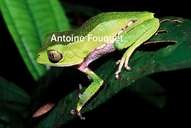|
Phyllomedusa vaillantii Boulenger, 1882
| family: Hylidae subfamily: Phyllomedusinae genus: Phyllomedusa |
 © 2004 Antoine Fouquet (1 of 37) |
|
|
Description Phyllomedusa tarsius and Phyllomedusa bicolor are similar to Phyllomedusa vaillantii. However, Phyllomedusa tarsius differs by its orange-red iris with a network of black reticulations. Phyllomedusa bicolor differs by its light brown fingers with green adhesive discs (Lima et al. 2005). In life, the dorsal skin and sides of head are green. The flanks viewed from above are colored green, whereas the flanks from below are colored reddish brown; this change in color is separated by a row of longitudinal, oval cream to pale orange spots. The front and back surfaces of the thighs range from reddish brown to lavender with small spots of cream to pale orange. The ventral skin is pale grayish-orange with gray reticulations present in smaller members of the species and dull grayish brown reticulations in larger ones. Throat is decorated with two lavender cream spots. A large pale green spot surrounded by cream coloration can be observed on the chest. The lower lip is cream color. The iris is pale gray with a greenish hue. The eyelids are clear (Duellman 1974). Distribution and Habitat Country distribution from AmphibiaWeb's database: Bolivia, Brazil, Colombia, Ecuador, French Guiana, Guyana, Peru, Suriname, Venezuela
This species occurs throughout the Reserva Florestal Adolpho Ducke in Brazil, where it is most commonly found in larger ponds with stream connections (Lima et al. 2005). Life History, Abundance, Activity, and Special Behaviors The tadpoles of Phyllomedusa vaillantii were observed to segregate in schools based on size during the day but appeared spread out during the night. Size based assortment could be explained by kin recognition and preference, which has been shown in the lab (Branch 1983). Tadpoles exhibited contagious air breathing during the day but not at night. Phyllomedusa vaillantii tadpoles also exhibited temporal shifts in feeding behavior even though food choice was constant among the tadpoles. Laboratory experiments suggest that behavioral shifts of the tadpoles are influenced by light rather than cued by endogenous rhythms (Branch 1983). Trends and Threats Possible reasons for amphibian decline General habitat alteration and loss Comments
References
Azevedo-Ramos, C., Reynolds, R., La Marca, E., Coloma, L.A., Ron, S. (2010). Phyllomedusa vaillantii. In: IUCN 2012. IUCN Red List of Threatened Species. Version 2012.2. Downloaded on 05 March 2013. Branch, L.C. (1983). “Social Behavior of the Tadpoles of Phyllomedusa vaillanti.” Copeia, 1983(2), 420-428. Duellman, W. E. (1974). “Taxonomic Notes on Phyllomedusa (Anura: Hylidae) from Upper Amazon Basin.” Herpetologica, 30(2), 109-110. Lima, A. P., Magnusson, W. E., Menin, M., Erdtmann, L. K., Rodrigues, D. J., Keller, C., and Hödl, W. (2005). Guia de Sapos da Reserva Adolpho Ducke, Amazonia Central. Átterna Design Editorial, Manaus. [link] Originally submitted by: Albertina P. Lima, William E. Magnusson, Marcelo Menin, Luciana K. Erdtmann, Domingos J. Rodrigues, Claudia Keller, Walter Hodl and David Wong (first posted 2007-11-27) Edited by: Ann T. Chang, Rudolf von May (2021-03-17) Species Account Citation: AmphibiaWeb 2021 Phyllomedusa vaillantii <https://amphibiaweb.org/species/666> University of California, Berkeley, CA, USA. Accessed Jun 9, 2025.
Feedback or comments about this page.
Citation: AmphibiaWeb. 2025. <https://amphibiaweb.org> University of California, Berkeley, CA, USA. Accessed 9 Jun 2025. AmphibiaWeb's policy on data use. |




 Map of Life
Map of Life